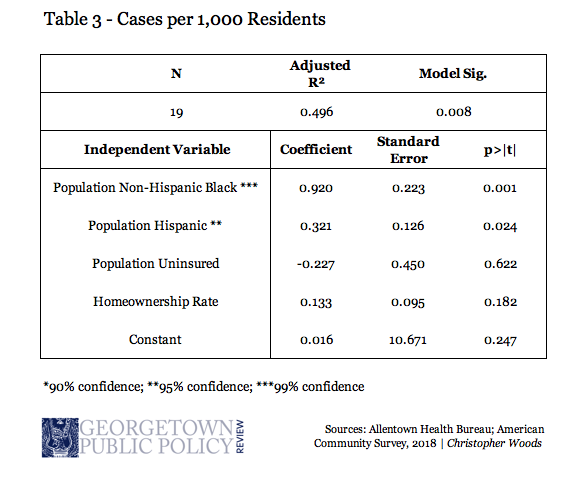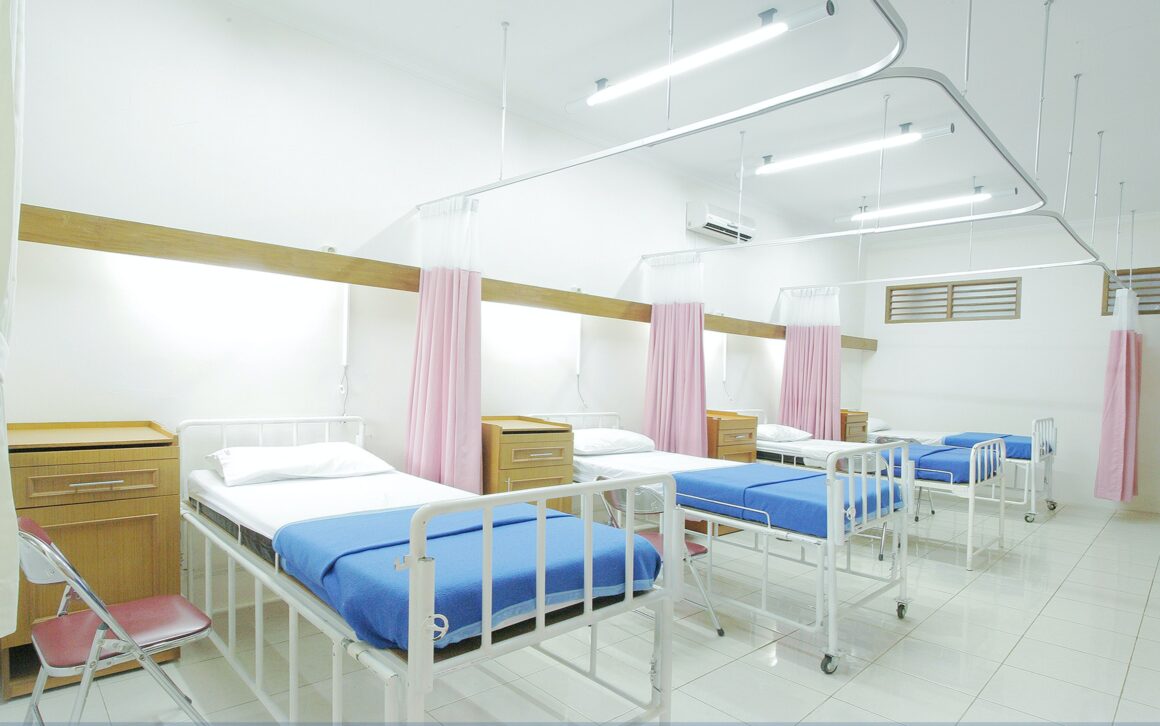COVID-19 has had a disparate impact on different racial and ethnic groups throughout the United States. In Allentown, Pennsylvania, the state’s third largest city, the proportion of the population identifying as Non-Hispanic Black or Latinx is significantly associated with an increase in COVID-19 cases within city wards.
Introduction
Although all people are biologically susceptible to infection by SARS-CoV-2, the virus that causes COVID-19, the virus has spread unevenly due to disparate conditions such as healthcare capacity, government policy response, access to diagnostics, population density, and many other factors. Within the United States, the uneven impact of COVID-19 mirrors some of the preexisting inequalities in healthcare outcomes. Data compiled by the COVID Racial Data Tracker reveals an over-representation of cases and deaths by racially and ethnically marginalized groups in virtually every US state and territory. Racial and ethnic data related to COVID-19 relies on proper gathering and reporting by local hospitals, health agencies, and governments. At this moment, gathering and reporting remains a patchwork, particularly as it relates to the reporting of Hispanic individuals.
Allentown, Pennsylvania’s third largest city, has one of the highest case rates per capita in the commonwealth at 1 case per 59 residents. As of late May 2020, Allentown’s cases per capita was 3.5 times greater than the state’s, and larger than both the cases per capita in Philadelphia and Pittsburgh. There is no local reporting of cases or deaths by race or ethnicity. This article fills that void by assessing the only public data on COVID-19 for the City of Allentown.
Social and economic data is used from the American Community Survey (ACS) to explore why some wards in Allentown have been hit particularly hard. According to data published by the American Communities Project through Brown University, Allentown has moderate levels of residential segregation as assessed by the Index of Dissimilarity and Isolation Index. This is borne out in racial and ethnic data through the ACS where many center city neighborhoods are composed of predominantly Latinx and non-Hispanic Black residents while the city’s wealthier west end is composed of predominantly non-Hispanic whites.
Racial Inequality in COVID-19
Structural racism in America’s healthcare system, and in overall health outcomes, is well documented. Racially and ethnically marginalized people suffer from major chronic diseases at rates 1.5 to 2.0 times higher than white people in America. Black Americans have higher rates of mortality than Non-Hispanic whites, though mortality is lower for Latinx and Asian Americans. These disparities are thought to be driven by some interaction of discrimination, social and economic access to resources and healthcare, and cultural practices and trust in institutions.
These intersecting social and economic conditions have already proved to be substantial determinants of COVID-19 outcomes in localities where more demographic data has been announced. Laster Pirtle argues that racial capitalism is the fundamental cause of the overrepresentation of Black COVID-19 deaths reported in Detroit, Michigan. She contends that preexisting inequalities from racial capitalism render Black Detroiters uniquely vulnerable to COVID-19 due to inequities like homelessness, residential segregation, and the lack of preventative resources to ameliorate its spread.
Clyde Yancy argues that the social determinants of health (SDOH) are a complex equation that explain racial disparities in COVD-19 mortality as seen in Chicago, Louisiana, Michigan, and New York. He contends that social and economic factors must be considered for a just response. An analysis conducted by the Washington Post found that majority-Black counties have infection rates three times higher, and mortality rates six times higher, than majority-white counties. The analysis reports Black mortality over-representation within places like Milwaukee, Illinois, Florida, and Connecticut.
Social Determinants of Health
This study uses the SDOH to explore why COVID-19 case rates vary so dramatically across different neighborhoods within Allentown. Variables from the five key areas are used to test their predictive value on the wards’ cases (Table 1).

Poverty and median income were the variables selected to represent economic stability. Residents of lower income and higher poverty neighborhoods are at increased risk of chronic disease and lowered life expectancy. The percentage of the population with at least a high school degree is the variable used for education. Higher educational attainment is associated with better physical health independent of access to and use of healthcare. The variable chosen to correspond to the social and community context is the portion of the population that identifies as Latinx or Non-Hispanic Black. As mentioned earlier, racial and ethnic minorities suffer from higher rates of chronic conditions and generally worse health outcomes in the United States. Insurance rates illustrate health and healthcare. Having health insurance has consistently been shown to increase the usage of healthcare services, improve health outcomes, and decrease mortality. Finally, the housing tenure of the neighborhood is the variable used for the neighborhood and built environment. Poor housing quality is associated with higher rates of chronic disease and poor mental health. Rohe, et al. review the available literature to find that neighborhood quality is highly associated with homeownership rates, and that homeownership is associated with better physical health, though the literature struggles to disentangle homeownership from confounding variables of wealth and neighborhood condition.
Methodology
Data from Allentown’s Health Bureau on COVID-19 cases by city ward, taken on May 15th, 2020, is compared with statistics from the ACS. While the Census Bureau reports data by ward, the most recent figures are from the 2010 decennial census. Instead, block group data is used from the 2018 ACS to sort the groups into wards. Most block groups lay entirely within a ward. For the few that straddle multiple wards, the group is assigned to the ward in which it is most situated. Aggregate data is taken from Allentown’s 86 block groups and sorted into the 19 wards. A multiple linear regression finds coefficients for independent variables from the SDOH plus median age – chosen due to the general severity in older populations influencing who gets priority testing. The final model omits median household income, age, high school graduation, and poverty because they prove far from significant when tested alone and are too highly correlated with other variables. Residuals are plotted against fitted values to reveal general random congruity around the mean and low levels of heteroscedasticity, confirmed with a Breusch-Pagan test. Variance inflation factors are assessed and show low levels of multicollinearity. The model proves significant at the 99% level.
Results
As of May 15th, 2020, Allentown has reported 2,058 COVID-19 cases. Variables informed by the SDOH plus median age were analyzed (Table 2) to see which predictors were statistically associated with cases per 1,000 residents (Table 3).

Only the percentages of the population that identified as Non-Hispanic Black or Latinx are statistically significant. City wards that have a higher proportion of people identifying as Latinx or Non-Hispanic Black are positively associated with a higher number of COVID-19 cases.

The percentage of the population identifying as Non-Hispanic Black in a city ward is strongly associated with increased prevalence of diagnosed COVID-19 cases per 1,000 residents (Figure 1). This association is not as strong, but still present for a percentage of the track identifying as Hispanic (Figure 2). Remarkably, neither variable for the economic characteristics of the wards proves close to significant. Nor does the insurance rate of the ward.


Discussion
While neighborhood data cannot leverage the question of racial and ethnic disparities in COVID-19 cases perfectly, it is important in the absence of locally reported patient data. Allentown is a moderately racially and ethnically segregated city. Within the city limits, neighborhoods drastically vary in economic well-being, generally along racial and ethnic lines, according to Census data. Non-Hispanic white median household income was $47,770 in 2018. That same year, the median incomes for Latinx and non-Hispanic Black households were $35,619 and $37,103, respectively. While clear disparities in economic resources by race and ethnicity exist in Allentown, there seems to be something unique to race and ethnicity driving the disparate COVID-19 cases by ward.
One possible explanation are the rates of underlying health conditions associated with more severe COVID-19 responses. The CDC recognizes several conditions as high-risk for severe COVID-19 illness, including diabetes, serious heart conditions, severe obesity, and asthma. Local hospitals in the Allentown area have had policies to only test those at higher risk. There is a systematic underdiagnosis of some of these comorbidities in racially and ethnically marginalized communities. Therefore, if documented risk is a precondition to testing and the epiphenomenal interventions to stop viral transmission, underdiagnosis could contribute to delayed or completely missed opportunities to intercede in community spread among Non-Hispanic Black and Latinx households.
Another plausible explanation is the density of living arrangements in neighborhoods that have higher percentages of Non-Hispanic Black and Latinx residents. Decennial census data from 2010 shows that the average Non-Hispanic white led household in Allentown had 2.31 occupants. Meanwhile Non-Hispanic Black led households had 3.03 and Latinx led households had 3.45 occupants.
Additionally, the primary occupations of wards might have an effect. According to national data through the Bureau of Labor Statistics for 2018, 41% of white workers were in a managerial or professional job. Meanwhile, only 31% of Black workers and 22% of Latinx workers were in managerial or professional jobs. Likewise, 16% of white workers were in service jobs, while 24% of both Black and Latinx workers were. These industries involve different levels of risk to exposure of SARS-CoV-2, with managerial and professional jobs being more easily conducted from home at decreased risk for infection. Furthermore, white workers have more access to paid sick leave for themselves or a sick relative than both Black and Latinx workers. The differential rates of exposure of these wards, based on the way racial groups have access to different education and employment, could contribute to the disparate cases by neighborhood.
As stated, it seems that something is contributing to increased cases of COVID-19 in neighborhoods with higher populations of Black and Hispanic or Latinx residents. Interestingly, while the literature often cites economic explanations for health disparities, this analysis found two primary economic indicators -median household income and poverty- to be insignificant predictors of a wards’ case rate. Likewise, wards’ insurance rates and homeownership rates also proved insignificant. Indeed, in this model, only race and ethnicity were able to explain the disparate rates. This is likely due to manifold and highly interlocking ways that social and economic conditions work to disenfranchise and disadvantage communities of color.
Conclusion
While all people are susceptible to SARS-Cov-2, it has impacted certain communities particularly hard. Throughout the country, Black residents have suffered disproportionate rates of infection and death. There is no data publicly available to tell if this is true for Allentown, the third largest city in Pennsylvania. Using the only data made public through the Allentown Health Bureau, this study looks to explain why certain wards of the city have been more impacted than others. Of the variables informed by the Social Determinants of Health, only race and ethnicity were significantly associated with an increase in caseloads by ward. The neighborhoods in Allentown that have higher percentages of Black and Latinx residents are the ones that have been particularly impacted. These findings should help the city and other organizations steer their resources in a race-informed manner. Providing more detailed data on infections by race would be a meaningful step towards lessening the impact of COVID-19 on minorities in Allentown.
